Scottish Survey of Farm Structure and Methods, 2016
Scottish statistics from the EU Farm Structure Survey 2016.
4. Production methods
4.1 Tillage Methods ( Table 11)
More intensive tillage systems, such as conventional ploughing, leave low levels of crop residue cover, whereas reduced tillage methods leave about 30 per cent or more residue cover. These residues reduce the amount of soil erosion, soil compaction and fuel consumption. Reduced tillage or no-till systems will also increase levels of soil organic carbon, and may result in lower direct carbon emissions from the soil.
Chart 7: Area of arable land by tillage method during the past 12 months
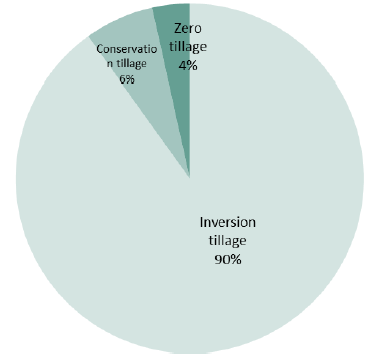
Source: Table 11
Note: Arable land excludes glasshouse crops, permanent crops and permanent grass. More than one form of tillage may be undertaken on a given holding.
In 2015/16 about 790,000 hectares of land was cultivated, excluding permanent crops, grassland and crops under cover. The survey asked whether respondents had used inversion tillage, reduced tillage or whether the land was not cultivated (zero tillage) on the area of land sown/cultivated in the twelve months up to March 2016. Responses were received for the equivalent of 740,000 hectares of land (once the sample is scaled up).
Survey results show that conventional inversion tillage was used on 90 per cent of land (81 per cent in 2013), with reduced, conservation tillage on six per cent land (11 per cent in 2013), while four per cent land (eight per cent in 2013) was not ploughed.
In 2016, as in 2013, inversion tillage appeared to be used more on larger holdings (or on larger areas within holdings), being employed at an average of 55 hectares per holding compared to 44 hectares for reduced tillage and 34 hectares for zero tillage, however the difference here is much less marked than in 2013.
4.2 Winter soil cover ( Table 12)
Maintaining soil cover over the winter is a practice aimed at reducing soil erosion and the loss of particulate pollutants (e.g. plant protection products and faecal microbes), in addition to contributing to the amount of organic matter in the soil.
The survey asked about coverage of land sown/cultivated over the preceding winter (i.e. winter 2015/16), including if the soil had been left bare.
Chart 8: Area of land sown or cultivated over winter 2015/16 by soil cover method
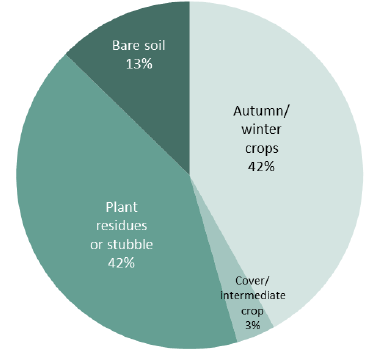
Source: Table 12
Note: Excludes glasshouse crops and permanent crops and permanent grass, though due to a printing error on the form many may have also excluded temporary grass. More than one form of cover may be undertaken on a given holding.
Responses in 2016 accounted almost three quarters of the potential area of land. Chart 8 provides a breakdown of the reported soil-cover methods used.
The most widespread cover on cultivable land was plant residues or stubble, and autumn/winter crops, which were both undertaken on around 42 per cent of land. Cover crops, intermediate crop or unharvested crops to be ploughed in before spring accounted for four per cent of land reported, with 13 per cent of land being left bare.
The proportion of bare soil has fallen from 17 per cent in 2013, though this may be related to better weather allowing winter crops to be sown.
Autumn/winter crop cover was also used most on larger holdings or areas within holdings, averaging at 41.5 hectares per holding, compared with around 26 hectares per holding of bare soil and of plant residues or stubble.
4.3 Crop rotation ( Table 13)
Chart 9: Distribution of holdings by percentage of arable land not in general crop rotation
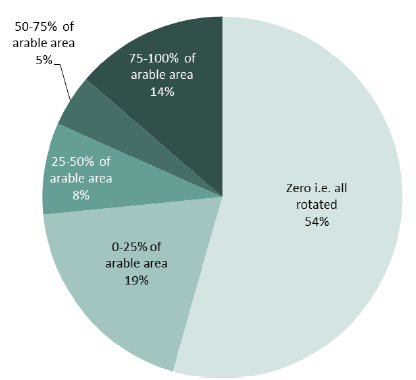
Source: Table 13
Crop rotation is the practice of alternating crops grown on a specific field each year in a planned pattern or sequence. The proportion of arable land not included in a holding's crop rotation is intended to give an indication of the degree to which monoculture is undertaken. The use of monoculture is also linked to environmental disadvantages and can have adverse effects on the productive capacity of the land.
Chart 9 details the proportions of holdings which did not include a share of their agricultural land in crop rotation. Over a half (54 per cent) of holdings with arable land included all their land in general crop rotation, and a further 19 per cent left out only 0‑25 per cent of their arable land.
4.4 Irrigation ( Tables 18- 20)
Finding suitable sources of water for irrigation is a major problem in many countries in the EU, and is becoming more of an issue in Scotland in some eastern areas. Additionally, inefficient and unplanned use of irrigation can lead to over-wet soils which can affect yields and lead to leaching of nutrients.
It was reported that a total of 94,000 hectares of land (two per cent of the crops and grass in the survey) could be irrigated using the equipment and the quantity of water normally available at the location [3] .
Just under 2,000 holdings with crops (just under a fifth of all holdings with crops) had undertaken irrigation in the twelve months up to March 2016, over an area of 26,000 hectares (0.5 per cent of crop area).
4.5 Nutrient Management ( Table 14)
In the last year, 17 per cent of holdings with grassland had carried out a nutrient management plan on their grassland (18 per cent in 2013), and 42 per cent of holdings had carried out a nutrient management plan on their other land (compared to 36 per cent in 2013).
Thirty per cent of holdings with grassland had carried out pH testing on their grassland, while 64 per cent of holdings had carried out pH testing on their other land. Data on pH testing of grassland and other land was not collected in 2013.
Of those with temporary grassland, 16 per cent of holdings reported that some of it was sown with a low n variety mix, such as red clover. The area sown accounted for 21 per cent of grassland on surveyed holdings. The large drop in the reported proportion of both temporary grass area and holdings with temporary grass in comparison with that reported in 2013 may be partly attributable to the fact that the definition of temporary grass changed in the June 2015 Agricultural Census which led to a halving of the area of temporary grass. More information on this can be found in section 4.7 of the publication, 'Results of the June 2015 Scottish Agricultural Census'. [4]
4.6 Manure and Slurry ( Tables 15- 17)
Immediate incorporation of manure and slurry, following application onto fields, can reduce environmentally harmful ammonia emissions, and preserves nitrogen in the soil. A threshold of four hours from the time of application to manure and slurry being ploughed in, along with immediate injection of slurry, is used to define immediate incorporation.
In 2016 the question was adapted from that asked in 2013, to now include the distinction between broadcast and bandspread application, and to collect tonnage rather than area.
In 2016, 29 per cent of holdings reported applying manure of slurry on their land. There were 12 million tonnes broadcast, of which three per cent was ploughed in within four hours. There was a further 5 million tonnes applied with a bandspread, and a further 600,000 tonnes injected.
Chart 10: Tonnage of manure and slurry, by method of application
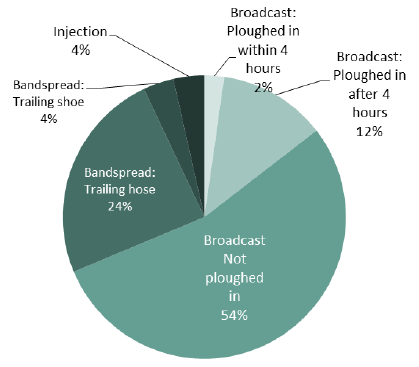
Source: Table 15
Seven per cent of holdings that had applied manure or slurry had tested the nutrient value of the manure or slurry, and 74 per cent always separated applications of slurry and/or mineral fertilizer by at least five days.
Covered storage facilities also reduce ammonia emissions, as well as protecting manure from rainfall. Twenty per cent of all holdings had storage facilities for solid manure, and about 12 per cent of these had covered storage (a slight fall from 13 per cent in 2013). Nine per cent of all holdings had storage facilities for slurry, with 62 per cent of these having covered storage (up from 61 per cent in 2013).
Chart 11: Prevalence of storage methods
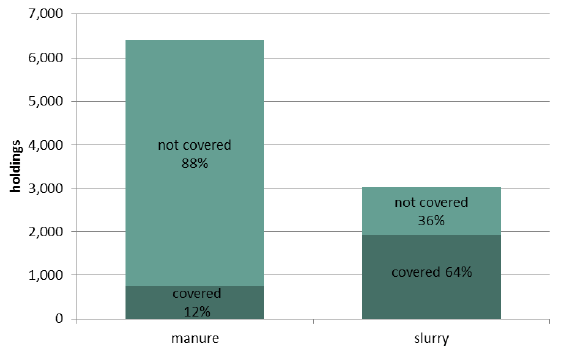
Source: Table 17
4.7 Livestock Breeding ( Tables 9- 10)
Respondents were asked about on the type of information used when breeding cattle and sheep, and the methods of insemination used. In each of the following, the percentage will not add to 100 as some farmers used more than one method.
Chart 12: Breeding - what information is used when selecting ram/bull/semen
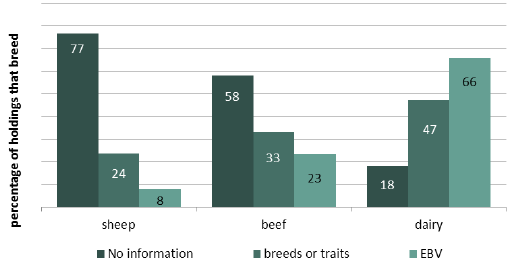
Source: Table 9
The lowest rate of usage of genetic information was found on holdings reporting the breeding of sheep, where 77 per cent reported not using information on genetics, 24 per cent reported using specific breeds or traits, and eight per cent reported using genetic information such as EBVs.
Of the holdings reporting the breeding of beef cattle, 58 per cent reported not using information on genetics, 33 per cent reported using specific breeds or traits, and 23 per cent reported using genetic information such as EBVs.
The highest rate of usage of genetic information was found on holdings reporting the breeding of dairy cattle, where 18 per cent reported not using information on genetics, 47 per cent reported using specific breeds or traits, and 66 per cent reported using genetic information such as PLIs.
Respondents were also asked how many ewes or cows had been mated in the previous year using various methods. Most ewes were mated naturally using home-bred (50 per cent) or brought-in (50 per cent) rams. Less than one per cent were mated using artificial insemination. Cows were more likely to be mated with a brought-in bull (44 per cent), with 33 per cent using a home-bred bull. Artificial insemination was more common with cattle, with 18 per cent mated using unsexed semen, and four per cent using sexed semen.
Twenty-three per cent of cattle breeders used some form of artificial insemination for some of their cattle. Two per cent of sheep breeders used artificial insemination for some of their sheep.
Chart 13: Proportion of animals mated using various methods
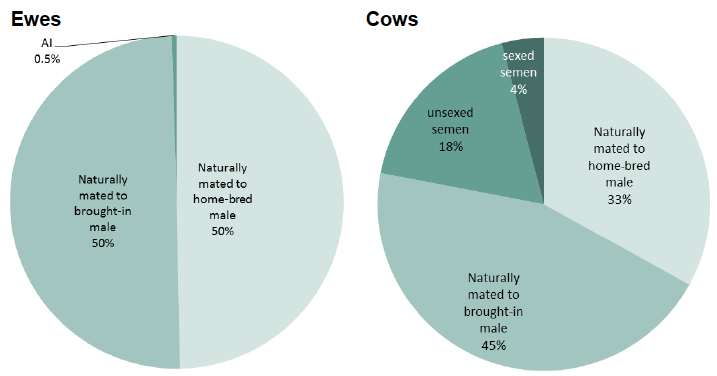
Source: Table 10
Contact
There is a problem
Thanks for your feedback